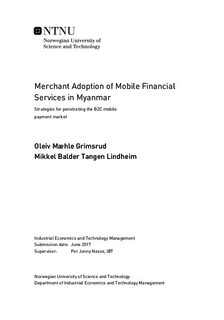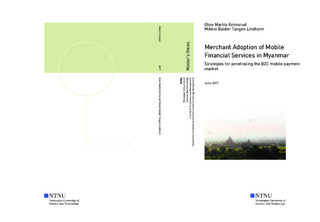| dc.description.abstract | Financial inclusion is key to combat poverty in developing countries. Diffusion of mobile financial solutions (MFS) can help provide financial inclusion to the previously underserved and unbanked parts of a population. Mobile phones are ubiquitous and personal by nature. Furthermore, they are increasingly present in developing countries. This creates a market opportunity for telecommunication providers and other providers of MFS. Merchant adoption of mobile payment solutions plays an integral part in the diffusion of MFS.
In this thesis, we have refined a framework for merchant adoption of MFS from (Mallat and Tuunainen, 2008) and coupled it with the technology adoption life cycle model (Rogers, 2003) in order to create a dynamic framework that allows us to weigh the drivers and barriers to adoption in accordance with the characteristics of the various merchant adoption groups. The framework for merchant adoption of MFS is specific and static, whereas the model for technology adoption is general and dynamic. Thus, we are able to assess merchant adoption performance from an entirely new perspective.
Based on the refined framework, we provide recommendations on how to progress merchant adoption of mobile payment solutions in Myanmar. Myanmar represents an emerging market for Telenor and their subsidiary, Wave Money, who are the largest provider of MFS in the country. Diffusion of B2C payment solutions for retailers in Myanmar is still in its infancy. In Pakistan, the B2C mobile payment solution from Telenor subsidiary Easypaisa has achieved traction. In order to confirm the validity and applicability of the framework in a developing economy, we evaluate the diffusion process of Easypaisa in light of our framework. In compliance with the drivers, barriers and prerequisites described in the dynamic framework for merchant adoption of MFS, we suggest measures that Wave Money can take in order to penetrate the market of B2C mobile payments in Myanmar.
In the earliest stages of the diffusion process, Wave Money should target their existing OTC retail agents as potential adopters of B2C mobile payment solutions. As Wave Money, according to their current business plan, scale their OTC service, the next target segment for adoption should be the influx of OTC retail agents. These two groups represent the Innovators and the Early Adopters in the technology adoption life cycle model.
Wave Money should take advantage of their high level of brand awareness and high ethical standards in order to stimulate trust and security among merchants. This is essential in a market where the general trust in financial services is low. Merchants associated with Wave Money should be able to enjoy positive recognition from new customers. This will stimulate the adoption rate among the Innovators and Early Adopters. Wave Money should enroll wholesalers and suppliers of merchants to stimulate the uptake of mobile money in the value chain. When suppliers of merchants demand payments via mobile accounts, merchants will be more inclined to adopt due to the two-sided pull effect from both new potential customers and suppliers. To mitigate the risk of infrastructural instability and to include the less technologically literate merchants, Wave Money should ensure that the technical aspects of the payment solution are low in complexity and easy to operate. As of now, the current total addressable market for Wave Money is limited by the number of Telenor subscribers. New competitors are expected to offer multi-operator payment acceptance. To remain competitive, Telenor and Wave Money should investigate the opportunities that lie in multi-operator functionality. | en |

